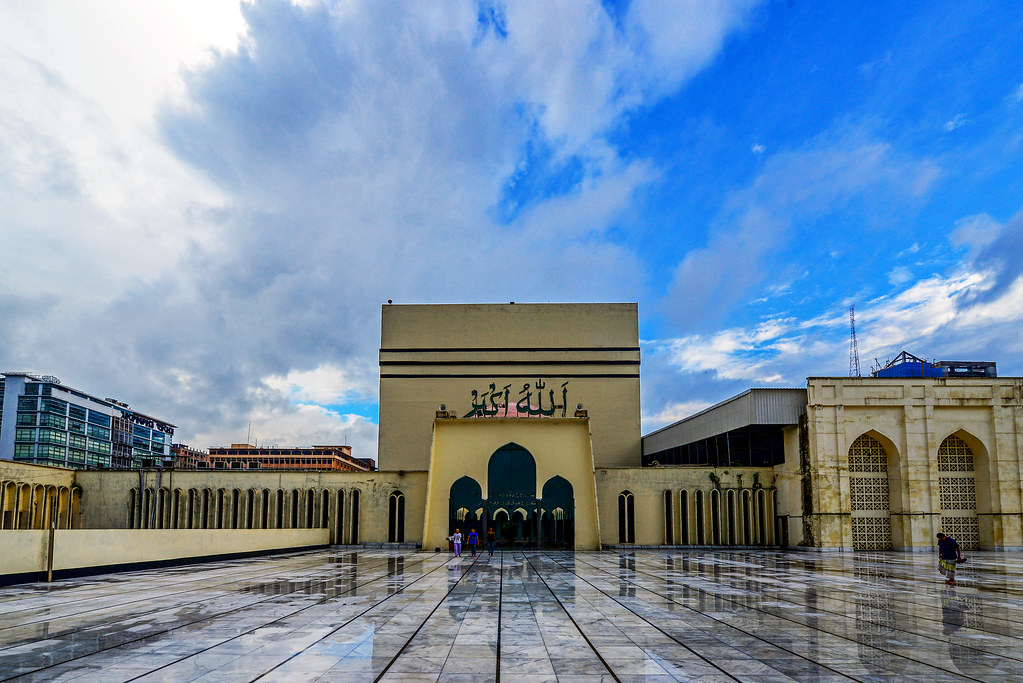Baitul Mukarram, also spelled as Baytul Mukarrom (Arabic: بيت المكرّم; Bengali: বায়তুল মোকাররম; The Holy House) is the National Mosque of Bangladesh. Located at the center of Dhaka, capital of Bangladesh, the mosque was completed in 1968. It has a capacity
of 40,000.
Architecture:
The mosque has several modern architectural features whilst at the same time it preserves the traditional principles of Mughal architecture which has for some time been dominant in the Indian sub-continent.[citation needed] Baitul Mukarram's large cube shape was modeled after that of the Ka'abah at Mecca making it a noticeable structure being unlike any other mosque in Bangladesh.
Exterior design
The mosque is on a very high platform. The Baitul Mukarram National Mosque's building is eight storied and 99 feet high from the ground level. According to the original plan, the main entrance of the mosque was to be on the eastern side. The 'shaan' on the east is 29,000 square feet with ablution space on its south and north sides. Ablution or Wu’du Place cached an important part when the Baitul Mukarram was begun. The absence of a dome on the main building is compensated by the two superficial domed entrance porticoes, one on the south, and the other on the north. The height of these porticoes consists of three rabbit's foot shaped arches, the middle of which is bigger than the rest.
Interior design
Two patios (roofless inner courtyard) ensure that enough light and air enter the prayer hall of Baitul Mukarram National Mosque. The prayer niché of the hall is rectangular instead of semi-circular. Excessive ornamentation is avoided throughout the mosque, since minimizing ornamentation is typical of modern architecture.
Garden
The garden is laid out in a style borrowed heavily from Mughal gardens, however unlike the traditional Mughal gardens which represent the Islamic Heaven, the garden does not have the Char-Bagh system most likely due to not having enough room for such a garden. The future of this garden is unknown, if the Bangladeshi government extends the mosque, it will most likely have to remove the garden.
History:
The mosque complex was designed by architect, Abdulhusein M. Thariani.[3] In 1959, owner of then Bawany Jute Mills, Haji Abdul Latif Bawany proposed to Major General Omrao Khan, then military administrator of East Pakistan, of building a grande mosque in Dhaka. Omrao Khan agreed to help on building such mosque. Same year, 'Baitul Mukarram mosque committee' had been established and 8.30 acre of land between new Dhaka and old Dhaka had been chosen. At that time, there was a large pond in present mosque's location. It was known as 'Paltan pond. The pond was filled up and on 27 January 1960 then president of Pakistan Ayub Khan commenced the work. Pray for first time took place on Friday, 25 January 1963. The plan included shops, offices, libraries and parking areas within the complex. Though there has been a tradition of dome mosque for Muslim, this building did not maintain the rule of traditional mosque in that time. A Mosque without a dome over the roof of its main prayer hall must have been a unique experiment. The mosque was built when the country was the Part of the Islamic Republic of Pakistan. in 2008 the mosque was extended, financed by a donation from the Saudi government.

Leave your comment